December 4, 2009
Some Really Good News
 It’s never a good idea to extrapolate from a single data point, but this morning’s far-better-than-expected November report from the Labor Department raises the possibility that employers could begin adding jobs sooner than expected. Just 11,000 payroll jobs were eliminated last month, well below the consensus for a loss of 125,000, while the unemployment rate declined from 10.2 to 10.0 percent. September and October losses were revised lower by a combined 159,000. T emporary employment, which precedes permanent hiring, has been growing since August, up by 117,000 over the past four months.
It’s never a good idea to extrapolate from a single data point, but this morning’s far-better-than-expected November report from the Labor Department raises the possibility that employers could begin adding jobs sooner than expected. Just 11,000 payroll jobs were eliminated last month, well below the consensus for a loss of 125,000, while the unemployment rate declined from 10.2 to 10.0 percent. September and October losses were revised lower by a combined 159,000. T emporary employment, which precedes permanent hiring, has been growing since August, up by 117,000 over the past four months.
A near-term resumption of employment growth would have positive implications for consumer confidence and spending and perhaps negative implications for higher inflation and interest rates. For commercial real estate, where demand depends heavily on job growth, it would lend support to net operating incomes and property values, helping to cushion the distress that continues to mount from the lack of debt capital available to renew maturing loans.
The November jobs report could be an outlier with more losses to follow in the coming months, and the drop in the unemployment rate is likely to prove temporary. But it is one more piece of evidence that the economy is on the right track, which is really good news.
Courtest of Robert Bach, SVP, Chief Economist, Grubb & Ellis.
For a free consultation of your commercial real estate needs please contact Sean Thompson at 406.539.0082 or sean.thompson@grubb-ellis.com OR Joe Cobb at 406.579.2999 or joe.cobb@grubb-ellis.com. www.MTcommercialRE.com
 Leave a Comment » |
Leave a Comment » |  Market Reports | Tagged: Belgrade Buisness, Belgrade Commercial Real Estate, Belgrade Office, Bozeman, Bozeman Business, Bozeman Commercial Land, Bozeman Commercial Real Estate, Bozeman Office, Bozeman Real Estate, Bozeman Retail, Bozeman Warehouse, Commercial Investment, Commercial Real Estate, Commercial Real Estate Bozeman, Grubb & Ellis, Montana Business, Montana Commercial, Montana Commercial Real Estate, Montana Real Estate |
Market Reports | Tagged: Belgrade Buisness, Belgrade Commercial Real Estate, Belgrade Office, Bozeman, Bozeman Business, Bozeman Commercial Land, Bozeman Commercial Real Estate, Bozeman Office, Bozeman Real Estate, Bozeman Retail, Bozeman Warehouse, Commercial Investment, Commercial Real Estate, Commercial Real Estate Bozeman, Grubb & Ellis, Montana Business, Montana Commercial, Montana Commercial Real Estate, Montana Real Estate |  Permalink
Permalink
 Posted by Sean Thompson
Posted by Sean Thompson
November 30, 2009

Industrial Vacancy vs. Warehouse Rent*
The drivers of demand for industrial space are beginning to firm: global trade, freight transportation, manufacturing activity and retail sales all seem to have hit bottom and either leveled out or posted slight gains recently. But the pending recovery is not yet strong enough to reverse the slide in occupier demand for industrial space. Expect the leasing market to soften further in 2010 with the vacancy rate hitting a peak of 11.4 percent by year end, a percentage point above its 2009-Q3 reading. The asking rental rate for warehouse/distribution space is projected to fall another 5 percent in 2010. In 2011, the vacancy rate should begin a slow descent while rent may slide another 2 percent due to the lingering excess of available space. The signs of improvement are there, but the recovery will be slow. Courtesy of Robert Bach, Chief Economist, SVP, Grubb & Ellis.
For a free consultation of your commercial real estate needs please contact Sean Thompson at 406.539.0082 or sean.thompson@grubb-ellis.com OR Joe Cobb at 406.579.2999 or joe.cobb@grubb-ellis.com. www.MTcommercialRE.com
 Leave a Comment » |
Leave a Comment » |  Market Reports | Tagged: Belgrade Buisness, Belgrade Commercial Real Estate, Belgrade Office, Bozeman, Bozeman Business, Bozeman Commercial Land, Bozeman Commercial Real Estate, Bozeman Office, Bozeman Real Estate, Bozeman Retail, Bozeman Warehouse, Commercial Investment, Commercial Land, Commercial Real Estate, Commercial Real Estate Forecast, Grubb & Ellis, Market Reports, Montana Business, Montana Commercial, Montana Commercial Real Estate, Montana Real Estate, Warehouse For Lease, Warehouse For Sale |
Market Reports | Tagged: Belgrade Buisness, Belgrade Commercial Real Estate, Belgrade Office, Bozeman, Bozeman Business, Bozeman Commercial Land, Bozeman Commercial Real Estate, Bozeman Office, Bozeman Real Estate, Bozeman Retail, Bozeman Warehouse, Commercial Investment, Commercial Land, Commercial Real Estate, Commercial Real Estate Forecast, Grubb & Ellis, Market Reports, Montana Business, Montana Commercial, Montana Commercial Real Estate, Montana Real Estate, Warehouse For Lease, Warehouse For Sale |  Permalink
Permalink
 Posted by Sean Thompson
Posted by Sean Thompson
November 23, 2009
Cost of Thanksgiving Dinner Ingredients for 10

Source: American Farm Bureau Federation
Holiday shoppers keeping an eye on their food budgets will be pleased to know that the cost of the ingredients for a Thanksgiving dinner for 10 declined by 3.8 percent this year to $42.91 according to the American Farm Bureau Federation. Black Friday shoppers will find even bigger markdowns in the world of commercial real estate. Renting a square foot of office space for a year will cost $26.57, a discount of 3.9 percent from the third quarter of last year, while landlords have marked down a square foot of industrial space by 6.8 percent to $5.35. Those are the asking rents, equivalent to the sticker price on a new car. Shoppers willing to haggle should be able to secure bigger markdowns. So far this year, effective rents for office and industrial space, which include periods of free rent and above-standard tenant improvement allowances, have fallen by 12.2 and 6.8 percent, respectively, from the same period in 2008. Want to build your own building? The Bureau of Labor Statistics reports that non-residential construction costs have declined by 5.9 percent from a year ago, with steep discounts for land also available. The most impressive bargains are in the big-ticket category of building acquisitions where sales prices have declined by 37 percent from a year ago as reported by the Moody’s / Real Commercial Property Price Index. These statistics are averages. There are considerable variations by product type and by geography. Courtesy of Robert Bach, SVP, Chief Economist, Grubb & Ellis.
For a free consultation of your commercial real estate needs please contact Sean Thompson at 406.539.0082 or sean.thompson@grubb-ellis.com OR Joe Cobb at 406.579.2999 or joe.cobb@grubb-ellis.com. www.MTcommercialRE.com
 Leave a Comment » |
Leave a Comment » |  Market Reports | Tagged: Belgrade Buisness, Belgrade Commercial Real Estate, Belgrade Office, Bozeman, Bozeman Business, Bozeman Commercial Land, Bozeman Commercial Real Estate, Bozeman Office, Bozeman Real Estate, Bozeman Retail, Bozeman Warehouse, Commercial Investment, Commercial Real Estate, Commercial Real Estate Bozeman, Grubb & Ellis, Montana Business, Montana Commercial, Montana Real Estate |
Market Reports | Tagged: Belgrade Buisness, Belgrade Commercial Real Estate, Belgrade Office, Bozeman, Bozeman Business, Bozeman Commercial Land, Bozeman Commercial Real Estate, Bozeman Office, Bozeman Real Estate, Bozeman Retail, Bozeman Warehouse, Commercial Investment, Commercial Real Estate, Commercial Real Estate Bozeman, Grubb & Ellis, Montana Business, Montana Commercial, Montana Real Estate |  Permalink
Permalink
 Posted by Sean Thompson
Posted by Sean Thompson
November 20, 2009
The Elevator Speech
Lately I’ve been speaking a lot to clients and professional groups about the outlook for 2010. Sometimes people buttonhole me as I get my coffee or wait for the presentation to begin. It often sounds like this: “So, are you going to give us some good news today?” This is delivered with a hint of sarcasm because they don’t expect good news from an economist, but they do want to know the bottom line. At Grubb & Ellis, we call this the elevator speech, when a client asks for our view of the market in less than a minute – the length of an elevator ride.
Here is my elevator speech: The recession is over, but 2010 is not going to feel like a classic recovery. There are too many headwinds, notably lagging job creation, lingering weakness in consumer spending and tight lending conditions. But we will see more decisions made by tenants, landlords, buyers, sellers and lenders. Keep in mind that Depression 2.0, a latter-day version of what the world endured in the 1930s, was still on the table through the first few months of this year, which made everyone freeze in place. Next year will bring more clarity and with it an increase in leasing and investment transactions. It won’t be pretty, but we are likely to see more results from our efforts.
Courtesy of Robert Bach, SVP, Chief Economist, Grubb & Ellis
For a free consultation of your commercial real estate needs please contact Sean Thompson at 406.539.0082 or sean.thompson@grubb-ellis.com OR Joe Cobb at 406.579.2999 or joe.cobb@grubb-ellis.com. www.MTcommercialRE.com
 Leave a Comment » |
Leave a Comment » |  Market Reports | Tagged: Belgrade Buisness, Belgrade Commercial Real Estate, Belgrade Office, Bozeman, Bozeman Business, Bozeman Commercial Land, Bozeman Commercial Real Estate, Bozeman Office, Bozeman Real Estate, Bozeman Retail, Bozeman Warehouse, Commercial Investment, Commercial Real Estate, Commercial Real Estate Bozeman, Grubb & Ellis, Montana Business, Montana Commercial Real Estate, Montana Real Estate, Office For Lease, Office For Sale, Retail For Lease, Retail For Sale, Retail Lease, Warehouse For Lease, Warehouse For Sale |
Market Reports | Tagged: Belgrade Buisness, Belgrade Commercial Real Estate, Belgrade Office, Bozeman, Bozeman Business, Bozeman Commercial Land, Bozeman Commercial Real Estate, Bozeman Office, Bozeman Real Estate, Bozeman Retail, Bozeman Warehouse, Commercial Investment, Commercial Real Estate, Commercial Real Estate Bozeman, Grubb & Ellis, Montana Business, Montana Commercial Real Estate, Montana Real Estate, Office For Lease, Office For Sale, Retail For Lease, Retail For Sale, Retail Lease, Warehouse For Lease, Warehouse For Sale |  Permalink
Permalink
 Posted by Sean Thompson
Posted by Sean Thompson
November 2, 2009
Personal Consumption Expenditures
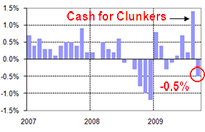 Office leasing activity through the third quarter is off by one-third from the same period in 2008, yet the share of activity by the size of tenant is surprisingly consistent. Office tenants leasing less than 10,000 square feet accounted for 29 percent of the total square footage leased this year while tenants needing less than 25,000 square feet comprised more than half of the total. Many of these tenants are branch offices of larger companies, but the importance of smaller tenants to the office market, particularly in non-headquarters cities, may affect the speed of the recovery. Small companies are the engine of job growth in the U.S., and the extent to which they have difficulty borrowing in order to expand could delay the recovery of both the labor market and the office.
Office leasing activity through the third quarter is off by one-third from the same period in 2008, yet the share of activity by the size of tenant is surprisingly consistent. Office tenants leasing less than 10,000 square feet accounted for 29 percent of the total square footage leased this year while tenants needing less than 25,000 square feet comprised more than half of the total. Many of these tenants are branch offices of larger companies, but the importance of smaller tenants to the office market, particularly in non-headquarters cities, may affect the speed of the recovery. Small companies are the engine of job growth in the U.S., and the extent to which they have difficulty borrowing in order to expand could delay the recovery of both the labor market and the office.
Source: U.S. Bureau of Economic Analysis, Grubb & Ellis
For a free consultation of your commercial real estate needs please contact Sean Thompson at 406.539.0082 or sean.thompson@grubb-ellis.com OR Joe Cobb at 406.579.2999 or joe.cobb@grubb-ellis.com. www.MTcommercialRE.com
 Leave a Comment » |
Leave a Comment » |  Market Reports | Tagged: Belgrade Buisness, Belgrade Commercial Real Estate, Belgrade Office, Bozeman, Bozeman Business, Bozeman Commercial Land, Bozeman Commercial Real Estate, Bozeman Office, Bozeman Real Estate, Bozeman Retail, Bozeman Warehouse, Commercial Investment, Commercial Real Estate, Commercial Real Estate Bozeman, Commercial Real Estate Forecast, Downtown Bozeman, Grubb & Ellis, Montana Business, Montana Commercial, Montana Commercial Real Estate, Montana Real Estate |
Market Reports | Tagged: Belgrade Buisness, Belgrade Commercial Real Estate, Belgrade Office, Bozeman, Bozeman Business, Bozeman Commercial Land, Bozeman Commercial Real Estate, Bozeman Office, Bozeman Real Estate, Bozeman Retail, Bozeman Warehouse, Commercial Investment, Commercial Real Estate, Commercial Real Estate Bozeman, Commercial Real Estate Forecast, Downtown Bozeman, Grubb & Ellis, Montana Business, Montana Commercial, Montana Commercial Real Estate, Montana Real Estate |  Permalink
Permalink
 Posted by Sean Thompson
Posted by Sean Thompson
October 27, 2009
 Leave a Comment » |
Leave a Comment » |  Bozeman, Bozeman Real Estate, Commercial Real Estate Bozeman | Tagged: Belgrade Buisness, Belgrade Commercial Real Estate, Bozeman, Bozeman Business, Bozeman Commercial Real Estate, Bozeman Real Estate, Bozeman Retail, Commercial Investment, Commercial Real Estate, Commercial Real Estate Bozeman, Grubb & Ellis, Montana Business, Montana Commercial, Montana Commercial Real Estate, Montana Real Estate, NNN, NNN Investment, Retail For Sale, Warehouse For Sale |
Bozeman, Bozeman Real Estate, Commercial Real Estate Bozeman | Tagged: Belgrade Buisness, Belgrade Commercial Real Estate, Bozeman, Bozeman Business, Bozeman Commercial Real Estate, Bozeman Real Estate, Bozeman Retail, Commercial Investment, Commercial Real Estate, Commercial Real Estate Bozeman, Grubb & Ellis, Montana Business, Montana Commercial, Montana Commercial Real Estate, Montana Real Estate, NNN, NNN Investment, Retail For Sale, Warehouse For Sale |  Permalink
Permalink
 Posted by Sean Thompson
Posted by Sean Thompson
October 27, 2009
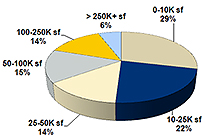 Office leasing activity through the third quarter is off by one-third from the same period in 2008, yet the share of activity by the size of tenant is surprisingly consistent. Office tenants leasing less than 10,000 square feet accounted for 29 percent of the total square footage leased this year while tenants needing less than 25,000 square feet comprised more than half of the total. Many of these tenants are branch offices of larger companies, but the importance of smaller tenants to the office market, particularly in non-headquarters cities, may affect the speed of the recovery. Small companies are the engine of job growth in the U.S., and the extent to which they have difficulty borrowing in order to expand could delay the recovery of both the labor market and the office.
Office leasing activity through the third quarter is off by one-third from the same period in 2008, yet the share of activity by the size of tenant is surprisingly consistent. Office tenants leasing less than 10,000 square feet accounted for 29 percent of the total square footage leased this year while tenants needing less than 25,000 square feet comprised more than half of the total. Many of these tenants are branch offices of larger companies, but the importance of smaller tenants to the office market, particularly in non-headquarters cities, may affect the speed of the recovery. Small companies are the engine of job growth in the U.S., and the extent to which they have difficulty borrowing in order to expand could delay the recovery of both the labor market and the office.
Source: Grubb & Ellis
For a free consultation of your commercial real estate needs please contact Sean Thompson at 406.539.0082 or sean.thompson@grubb-ellis.com OR Joe Cobb at 406.579.2999 or joe.cobb@grubb-ellis.com. www.MTcommercialRE.com
 Leave a Comment » |
Leave a Comment » |  Market Reports | Tagged: Belgrade Buisness, Belgrade Commercial Real Estate, Belgrade Office, Bozeman, Bozeman Business, Bozeman Commercial Real Estate, Bozeman Office, Bozeman Real Estate, Bozeman Retail, Bozeman Warehouse, Commercial Investment, Commercial Land, Commercial Real Estate, Commercial Real Estate Bozeman, Grubb & Ellis, Montana Business, Montana Commercial, Montana Commercial Real Estate, Montana Real Estate, Office For Lease, Office For Sale |
Market Reports | Tagged: Belgrade Buisness, Belgrade Commercial Real Estate, Belgrade Office, Bozeman, Bozeman Business, Bozeman Commercial Real Estate, Bozeman Office, Bozeman Real Estate, Bozeman Retail, Bozeman Warehouse, Commercial Investment, Commercial Land, Commercial Real Estate, Commercial Real Estate Bozeman, Grubb & Ellis, Montana Business, Montana Commercial, Montana Commercial Real Estate, Montana Real Estate, Office For Lease, Office For Sale |  Permalink
Permalink
 Posted by Sean Thompson
Posted by Sean Thompson
October 19, 2009
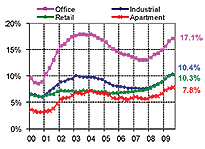
Trade Weighted Exchange Index
Market conditions for the four core property types followed a similar path in the third quarter; vacancy rates increased but not as sharply as in recent quarters. This reflects the improving tone of economic data since last spring and the fact that construction pipelines are emptying. Although Federal Reserve Chairman Ben Bernanke and many other economists think the recession has ended, a leasing market recovery depends on job growth. The last recession ended in November 2001, but payroll employment did not rise above its post-recession level until April 2004 (a 29-month jobless recovery) and did not set a new peak until February 2005 (10 months after that). The recession before that ended in March 1991; the jobless period lasted 14 months, and a new peak was set nine months later. Assuming a jobless recovery of similar magnitude, the labor market would be stagnant until late 2010 and perhaps well into 2011. A jobless recovery of this length seems extreme for the current circumstances, but even so, it appears that leasing markets are unlikely to embark on a meaningful recovery before 2011.
Courtesy of Robert Bach, SVP, Chief Economist, Grubb & Ellis.
For a free consultation of your commercial real estate needs please contact Sean Thompson at 406.539.0082 or sean.thompson@grubb-ellis.com OR Joe Cobb at 406.579.2999 or joe.cobb@grubb-ellis.com. www.MTcommercialRE.com
 Leave a Comment » |
Leave a Comment » |  Market Reports | Tagged: Belgrade Buisness, Belgrade Commercial Real Estate, Belgrade Office, Bozeman, Bozeman Business, Bozeman Commercial Real Estate, Bozeman Office, Bozeman Real Estate, Bozeman Retail, Bozeman Warehouse, Commercial Investment, Commercial Land, Commercial Real Estate, Commercial Real Estate Bozeman, Grubb & Ellis, Investment Property, Montana Business, Montana Commercial, Montana Commercial Real Estate, Montana Real Estate, Office For Lease, Office For Sale, Retail For Lease, Retail For Sale, Retail Lease, Warehouse For Lease, Warehouse For Sale |
Market Reports | Tagged: Belgrade Buisness, Belgrade Commercial Real Estate, Belgrade Office, Bozeman, Bozeman Business, Bozeman Commercial Real Estate, Bozeman Office, Bozeman Real Estate, Bozeman Retail, Bozeman Warehouse, Commercial Investment, Commercial Land, Commercial Real Estate, Commercial Real Estate Bozeman, Grubb & Ellis, Investment Property, Montana Business, Montana Commercial, Montana Commercial Real Estate, Montana Real Estate, Office For Lease, Office For Sale, Retail For Lease, Retail For Sale, Retail Lease, Warehouse For Lease, Warehouse For Sale |  Permalink
Permalink
 Posted by Sean Thompson
Posted by Sean Thompson
October 16, 2009
Elephants and Gorillas
One of the leading indicators of the recovery that we haven’t mentioned is the stock market, perhaps because it is so volatile and covered so thoroughly on a real-time basis. But, like the fabled elephant in the living room or the 500-pound gorilla, we can’t ignore it any longer because the Dow Jones Industrial Average crossed the psychologically important 10,000 threshold on Wednesday. Skeptics will note that the DJIA first crossed 10,000 in 1999, has crossed it 25 times since then and remains 29 percent below its all-time peak in October 2007. But the speed and magnitude of this latest rally merits a sigh of relief at the very least – up 54 percent as of yesterday from its low point on March 9th. The rally has boosted the market for initial public offerings and bond issuance – important sources of capital for many debt-starved companies. Rising equity prices also have helped support business and consumer confidence, which is reflected in two other economic releases this week:
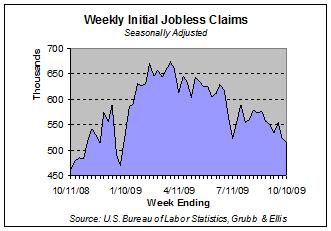 Initial claims for unemployment benefits fell by 10,000 to 514,000 for the week ending October 10th. It was the lowest level since the holiday week of January 3rd according to the Bureau of Labor Statistics.
Initial claims for unemployment benefits fell by 10,000 to 514,000 for the week ending October 10th. It was the lowest level since the holiday week of January 3rd according to the Bureau of Labor Statistics.- The Census Bureau reported that retail sales overall declined 1.5 percent in September, payback for the 2.2 percent increase in August due to the cash-for-clunkers program. But sales excluding autos and gas, called core retail sales, increased 0.4 percent in September, led by general merchandise stores (up 0.9 percent), food and beverage stores (up 0.7 percent) and clothing and accessories stores (up 0.5 percent). Along with a recent report from the ICSC on chain store sales, this report raises hopes for stable to slightly higher sales in the upcoming holiday season.
Courtesy of Robert Bach, SVP, Chief Economist, Grubb & Ellis.
For a free consultation of your commercial real estate needs please contact Sean Thompson at 406.539.0082 or sean.thompson@grubb-ellis.com OR Joe Cobb at 406.579.2999 or joe.cobb@grubb-ellis.com. www.MTcommercialRE.com
 Leave a Comment » |
Leave a Comment » |  Market Reports | Tagged: Belgrade Buisness, Belgrade Commercial Real Estate, Belgrade Office, Bozeman, Bozeman Business, Bozeman Commercial Land, Bozeman Commercial Real Estate, Bozeman Office, Bozeman Real Estate, Bozeman Retail, Bozeman Warehouse, Commercial Investment, Commercial Land, Commercial Real Estate, Commercial Real Estate Bozeman, Grubb & Ellis, Investment Property, Montana Business, Montana Commercial, Montana Commercial Real Estate, Montana Real Estate, Office For Lease, Office For Sale, Retail For Lease, Retail For Sale, Retail Lease, Warehouse For Lease, Warehouse For Sale |
Market Reports | Tagged: Belgrade Buisness, Belgrade Commercial Real Estate, Belgrade Office, Bozeman, Bozeman Business, Bozeman Commercial Land, Bozeman Commercial Real Estate, Bozeman Office, Bozeman Real Estate, Bozeman Retail, Bozeman Warehouse, Commercial Investment, Commercial Land, Commercial Real Estate, Commercial Real Estate Bozeman, Grubb & Ellis, Investment Property, Montana Business, Montana Commercial, Montana Commercial Real Estate, Montana Real Estate, Office For Lease, Office For Sale, Retail For Lease, Retail For Sale, Retail Lease, Warehouse For Lease, Warehouse For Sale |  Permalink
Permalink
 Posted by Sean Thompson
Posted by Sean Thompson
October 12, 2009
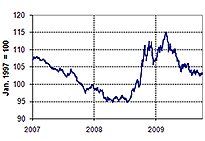
Trade Weighted Exchange Index
Economists are debating whether the falling dollar is helping or hurting the economy. Analysts who are worried (call them the pessimists) think the decline in part reflects doubt that the U.S. government can control long-term deficits. Those who are not worried (the optimists) see the decline as a sign that investors, who fled to U.S. Treasuries when credit markets were in disarray from September through March (driving up the dollar), are regaining their appetite for risk, putting money in stocks, oil and other assets they think will offer better returns. The pessimists fear that the retreat of the dollar, orderly so far, could turn into a rout at some point, forcing the government to pay much higher interest rates to buyers of its debt and sparking inflation. This camp wants the Federal Reserve to begin tightening monetary policy sooner rather than later and the government to control spending, moves that would support the dollar. They are willing to accept a slower recovery in exchange for inflation protection. The optimists think this course of action could repeat the 1930s when premature tightening pushed the economy, which had been recovering rapidly from the 1929-33 collapse, into a second recession in 1937-38. This camp points out that a weak dollar helps U.S. manufacturers by making exports cheaper for overseas buyers. The same dynamic is true for commercial real estate; a weak dollar makes U.S. properties more attractive to foreign investors. Moreover, a little inflation could be helpful for commercial real estate, which could, at some point, reprise its long-dormant role as an inflation hedge. But while a weak dollar might boost the U.S. recovery in the near term, a perennially weak dollar that reflects a lack of faith among investors is not in the best interest of the country or commercial real estate. Eventually the government will need to cut spending, raise taxes or both to control the deficit. Courtesy of Robert Bach, SVP, Chief Economist, Grubb & Ellis.
For a free consultation of your commercial real estate needs please contact Sean Thompson at 406.539.0082 or sean.thompson@grubb-ellis.com OR Joe Cobb at 406.579.2999 or joe.cobb@grubb-ellis.com. www.MTcommercialRE.com
 Leave a Comment » |
Leave a Comment » |  Market Reports | Tagged: Belgrade Buisness, Belgrade Commercial Real Estate, Belgrade Office, Bozeman, Bozeman Business, Bozeman Commercial Real Estate, Bozeman Office, Bozeman Real Estate, Bozeman Retail, Bozeman Warehouse, Commercial Investment, Commercial Land, Commercial Real Estate, Commercial Real Estate Bozeman, Grubb & Ellis, Investment Property, Montana Business, Montana Commercial, Montana Commercial Real Estate, Montana Real Estate, Office For Lease, Office For Sale, Retail For Lease, Retail For Sale, Retail Lease, State Farm, Warehouse For Lease, Warehouse For Sale |
Market Reports | Tagged: Belgrade Buisness, Belgrade Commercial Real Estate, Belgrade Office, Bozeman, Bozeman Business, Bozeman Commercial Real Estate, Bozeman Office, Bozeman Real Estate, Bozeman Retail, Bozeman Warehouse, Commercial Investment, Commercial Land, Commercial Real Estate, Commercial Real Estate Bozeman, Grubb & Ellis, Investment Property, Montana Business, Montana Commercial, Montana Commercial Real Estate, Montana Real Estate, Office For Lease, Office For Sale, Retail For Lease, Retail For Sale, Retail Lease, State Farm, Warehouse For Lease, Warehouse For Sale |  Permalink
Permalink
 Posted by Sean Thompson
Posted by Sean Thompson
 It’s never a good idea to extrapolate from a single data point, but this morning’s far-better-than-expected November report from the Labor Department raises the possibility that employers could begin adding jobs sooner than expected. Just 11,000 payroll jobs were eliminated last month, well below the consensus for a loss of 125,000, while the unemployment rate declined from 10.2 to 10.0 percent. September and October losses were revised lower by a combined 159,000. T emporary employment, which precedes permanent hiring, has been growing since August, up by 117,000 over the past four months.
It’s never a good idea to extrapolate from a single data point, but this morning’s far-better-than-expected November report from the Labor Department raises the possibility that employers could begin adding jobs sooner than expected. Just 11,000 payroll jobs were eliminated last month, well below the consensus for a loss of 125,000, while the unemployment rate declined from 10.2 to 10.0 percent. September and October losses were revised lower by a combined 159,000. T emporary employment, which precedes permanent hiring, has been growing since August, up by 117,000 over the past four months.


 Posted by Sean Thompson
Posted by Sean Thompson 

 Office leasing activity through the third quarter is off by one-third from the same period in 2008, yet the share of activity by the size of tenant is surprisingly consistent. Office tenants leasing less than 10,000 square feet accounted for 29 percent of the total square footage leased this year while tenants needing less than 25,000 square feet comprised more than half of the total. Many of these tenants are branch offices of larger companies, but the importance of smaller tenants to the office market, particularly in non-headquarters cities, may affect the speed of the recovery. Small companies are the engine of job growth in the U.S., and the extent to which they have difficulty borrowing in order to expand could delay the recovery of both the labor market and the office.
Office leasing activity through the third quarter is off by one-third from the same period in 2008, yet the share of activity by the size of tenant is surprisingly consistent. Office tenants leasing less than 10,000 square feet accounted for 29 percent of the total square footage leased this year while tenants needing less than 25,000 square feet comprised more than half of the total. Many of these tenants are branch offices of larger companies, but the importance of smaller tenants to the office market, particularly in non-headquarters cities, may affect the speed of the recovery. Small companies are the engine of job growth in the U.S., and the extent to which they have difficulty borrowing in order to expand could delay the recovery of both the labor market and the office.
 Office leasing activity through the third quarter is off by one-third from the same period in 2008, yet the share of activity by the size of tenant is surprisingly consistent. Office tenants leasing less than 10,000 square feet accounted for 29 percent of the total square footage leased this year while tenants needing less than 25,000 square feet comprised more than half of the total. Many of these tenants are branch offices of larger companies, but the importance of smaller tenants to the office market, particularly in non-headquarters cities, may affect the speed of the recovery. Small companies are the engine of job growth in the U.S., and the extent to which they have difficulty borrowing in order to expand could delay the recovery of both the labor market and the office.
Office leasing activity through the third quarter is off by one-third from the same period in 2008, yet the share of activity by the size of tenant is surprisingly consistent. Office tenants leasing less than 10,000 square feet accounted for 29 percent of the total square footage leased this year while tenants needing less than 25,000 square feet comprised more than half of the total. Many of these tenants are branch offices of larger companies, but the importance of smaller tenants to the office market, particularly in non-headquarters cities, may affect the speed of the recovery. Small companies are the engine of job growth in the U.S., and the extent to which they have difficulty borrowing in order to expand could delay the recovery of both the labor market and the office.
 Initial claims for unemployment benefits fell by 10,000 to 514,000 for the week ending October 10th. It was the lowest level since the holiday week of January 3rd according to the Bureau of Labor Statistics.
Initial claims for unemployment benefits fell by 10,000 to 514,000 for the week ending October 10th. It was the lowest level since the holiday week of January 3rd according to the Bureau of Labor Statistics.